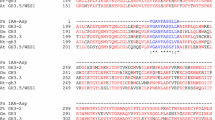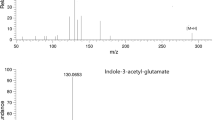Abstract
The auxins 4-chloroindole-3-acetic acid (4-Cl-IAA) and indole-3-acetic acid (IAA) occur naturally in pea vegetative and fruit tissues (Pisum sativum L.). Previous work has shown that 4-Cl-IAA can substitute for the seeds in the stimulation of pea pericarp growth, whereas IAA is ineffective. Both auxins are found as free acids and as low-molecular-weight conjugates from organic solvent-soluble extracts from pea fruit. Here we present evidence for an additional conjugated auxin species that was not soluble in organic solvent and yielded 4-Cl-IAA and IAA after strong alkaline hydrolysis, suggestive of auxin attachment to pea seed and pericarp proteins. The solvent-insoluble conjugated 4-Cl-IAA in young pericarp was on average 15-fold greater than solvent-soluble 4-Cl-IAA. The solvent-insoluble conjugated IAA was approximately half the levels reported for the solvent-soluble IAA fraction. To identify putative 4-Cl-IAA-bound proteins, polyclonal antibodies were raised to 4-Cl-IAA linked to bovine serum albumin protein (BSA). Immunoblots probed with anti-4-Cl-IAA-BSA antiserum detected three to four unique bands (32–40 kDa) in primarily maternal tissues, and a different set of protein bands were detected in mainly embryonic tissues (ca. 65–74 kDa in mature seed). 4-Cl-IAA and IAA were also identified from protein fractions separated by polyacrylamide gel electrophoresis using GC-MS. These data show that the majority of 4-Cl-IAA, the growth-active auxin in young pea pericarp, and significant levels of IAA are linked to protein fractions. Auxin-proteins may function in regulation of free bioactive 4-Cl-IAA and IAA levels, and/or 4-Cl-IAA or IAA may be targeted to specific proteins post-translationally to modify protein function or stability.



Similar content being viewed by others
References
Ahmad A, Andersen AS, Engvild KC (1987) Rooting, growth and ethylene evolution of pea cuttings in response to chloroindole auxins. Physiol Plant 69:137–140
Antolic S, Kveder M, Klaic B, Magnus V, Kojić-Prodić B (2001) Recognition of the folded conformation of plant hormone (auxin, IAA) conjugates with glutamic acid and aspartic acids and their amides. J Mol Struct 560:223–237
Atzorn R, Weiler EW (1983) The immunoassay of gibberellins II. Quantitation of GA3, GA4 and GA7 by ultra-sensitive solid-phase enzyme immunoassays. Planta 159:7–11
Ayele B (2006) Hormonal regulation of pea seed germination. PhD thesis, University of Alberta
Bandurski RS, Schulze A (1977) Concentration of indole-3-acetic acid and its derivatives in plants. Plant Physiol 60:211–213
Bandurski RS, Cohen JD, Slovin JP, Reinecke DM (1995) Auxin biosynthesis and metabolism. In: Davies PJ (ed) Plant hormones: physiology, biochemistry and molecular biology, 2nd edn. Kluwer Academics Publishers, Dordrechtpp 649–670
Bialek K, Cohen JD (1986) Isolation and partial characterization of the major amide-linked conjugate of indole-3-acetic acid from Phaseolus vulgaris L. Plant Physiol 80:99–104
Bialek K, Cohen JD (1989) Quantitation of indoleacetic acid conjugates in bean seeds by direct tissue hydrolysis. Plant Physiol 90:398–400
Bradford MM (1976) A rapid and sensitive method for the quantitation of microgram quantities of protein utilizing the principle of protein-dye binding. Anal Biochem 72:248–254
Chen K-H, Miller AN, Patterson GW, Cohen JD (1988) A rapid and simple procedure for purification of indole-3-acetic acid prior to GC-SIM-MS analysis. Plant Physiol 86:822–825
Cooke TJ, Poli DB, Sztein AE, Cohen JD (2002) Evolutionary patterns in auxin action. Plant Mol Biol 49:319–338
Davies PJ (2004) The plant hormones: their nature, occurrence and function. In: Davies PJ (ed) Plant hormones: biosynthesis, signal transduction, action!, 3rd edn. Springer, Dordrecht, pp 1–15
Eeuwens CJ, Schwabe WW (1975) Seed and pod wall development in Pisum sativum L. in relation to extracted and applied hormones. J Exp Bot 26:1–14
Gandar JC (1960) Evolution des substances de croissance de la graine et de la gousse du pois au cours de leur development. Ann Physiol Veg 4:255–260
García-Martínez JL, Santes C, Crocker SJ, Hedden P (1991) Identification, quantitation and distribution of gibberellins in fruits of Pisum sativum L. cv. Alaska during pod development. Planta 184:53–60
Hattori H, Marumo S (1972) Monomethyl-4-chloro-indolyl-3-acetyl-L-aspartate and absence of indolyl-3-acetic acid in immature seeds of Pisum sativum. Planta 102:85–90
Jakubowska A, Kowalczyk S (2004) The auxin conjugate 1-O-indole-3-acetyl-β-D-glucose is synthesized in immature legume seeds by IAGlc synthase and may be used for modification of some high molecular weight compounds. J Exp Bot 55:791–801
Johnstone MMG, Reinecke DM, Ozga JA (2005) The auxins IAA and 4-Cl-IAA differentially modify gibberellin action via ethylene response in developing pea fruit. J Plant Growth Regul 24:214–225
Katekar GF, Geissler AE (1983) Structure-activity differences between indoleacetic acid auxins on pea and wheat. Phytochemistry 22:27–31
Laemmli UK (1970) Cleavage of structural proteins during the assembly of the head of bacteriophage T4. Nature 227:680–685
Landsteiner K (1990) The specificity of serological reactions. Courier Dover Publications, Mineola
Magnus V, Ozga JA, Reinecke DM, Pierson GL, Larue TA, Cohen JD, Brenner ML (1997) 4-Chloroindole-3-acetic and indole-3-acetic acids in Pisum sativum. Phytochemistry 46:675–681
Marumo S, Hattori H, Abe H, Munakata K (1968) Isolation of 4-chloroindolyl-3-acetic acid from immature seeds of Pisum sativum. Nature 219:959–996
Ozga JA, Reinecke DM (1999) Interaction of 4-chloroindole-3-acetic acid and gibberellins in early pea fruit development. Plant Growth Regul 27:33–38
Ozga JA, Brenner ML, Reinecke DM (1992) Seed effects on gibberellin metabolism in pea pericarp. Plant Physiol 100:88–94
Ozga JA, Yu J, Reinecke DM (2003) Pollination-, development-, and auxin-specific regulation of gibberellin 3β-hydroxylase gene expression in pea fruit and seeds. Plant Physiol 131:1137–1146
Ozga JA, Reinecke DM, Ayele BT, Ngo P, Nadeau C (2009) Developmental and hormonal regulation of gibberellin biosynthesis and catabolism in pea fruit. Plant Physiol 131:1137–1146
Park S, Cohen JD, Slovin JP (2006) Strawberry fruit protein with a novel indole-acyl modification. Planta 224:1015–1022
Reinecke DM (1999) 4-Chloroindole-3-acetic acid and plant growth. Plant Growth Regul 27:3–13
Reinecke DM, Ozga JA, Magnus V (1995) Effect of halogen substitution of indole-3-acetic acid on biological activity in pea fruit. Phytochemistry 40:1361–1366
Reinecke DM, Ozga JA, Ilić N, Magnus V, Kojić-Prodić B (1999) Molecular properties of 4-substituted indole-3-acetic acids affecting pea pericarp elongation. Plant Growth Regul 27:39–48
Ribnicky DM, Cohen JD, Hu W-S, Cooke TJ (2002) An auxin surge following fertilization in carrots: a mechanism for regulating plant totipotency. Planta 214:505–509
Rodrigo MJ, García-Martínez JL, Santes CM, Gaskin P, Hedden P (1997) The role of gibberellins A1 and A3 in fruit growth of Pisum sativum L. and the identification of gibberellins A4 and A7 in young seeds. Planta 201:446–455
Schneider EA, Kazakoff CW, Wightman F (1985) Gas chromatography-mass spectrometry evidence for several endogenous auxins in pea seedling organs. Planta 165:232–241
Seidel C, Walz A, Park S, Cohen JD, Ludwig-Müller J (2006) Indole-3-acetic acid protein conjugates: novel players in auxin homeostasis. Plant Biol 8:340–345
van Huizen R, Ozga JA, Reinecke DM, Twitchin B, Mander LN (1995) Seed and 4-chloroindole-3-acetic acid regulation of gibberellin metabolism in pea pericarp. Plant Physiol 109:1213–1217
Walz A, Park S, Slovin JP, Ludwig-Müller J, Momonoki YS, Cohen JD (2002) A gene encoding a protein modified by the phytohormone indoleacetic acid. Proc Natl Acad Sci USA 99:1718–1723
Walz A, Seidel C, Rusak G, Park S, Cohen JD, Ludwig-Müller J (2008) Heterologous expression of IAP1, a seed protein from bean modified by indole-3-acetic acid, in Arabidopsis thaliana and Medicago truncatula. Planta 227:1047–1061
Weiler EW, Zenk MH (1976) Radioimmunoassay for the determination of digoxin and related compounds in Digitalis lanata. Phytochemistry 15:1537–1545
Weiler EW, Jourdan PS, Conrard W (1981) Levels of indole-3-acetic acid in intact and decapitated coleoptiles as determined by a specific and highly sensitive solid-phase enzyme immunoassay. Planta 153:561–571
Yamaguchi I, Nakagawa R, Kurogochi S, Murofushi N, Takahashi N, Weiler EW (1987) Radioimmunoassay of gibberellins A5 and A20. Plant Cell Physiol 28:815–824
Acknowledgments
We thank Thomas P. Krick (Department of Biochemistry, Molecular Biology, and Biophysics, University of Minnesota) for the MALDI-TOF spectrum. The authors acknowledge funding support for this research from the Natural Sciences and Engineering Research Council of Canada to JAO, and financial support to JDC from the U.S. National Science Foundation (IBN 0111530 and IOS 0820940), the University of Minnesota Grant-in-Aid program, and the Gordon and Margaret Bailey Endowment for Environmental Horticulture.
Author information
Authors and Affiliations
Corresponding author
Rights and permissions
About this article
Cite this article
Park, S., Ozga, J.A., Cohen, J.D. et al. Evidence of 4-Cl-IAA and IAA Bound to Proteins in Pea Fruit and Seeds. J Plant Growth Regul 29, 184–193 (2010). https://doi.org/10.1007/s00344-009-9123-6
Received:
Accepted:
Published:
Issue Date:
DOI: https://doi.org/10.1007/s00344-009-9123-6




